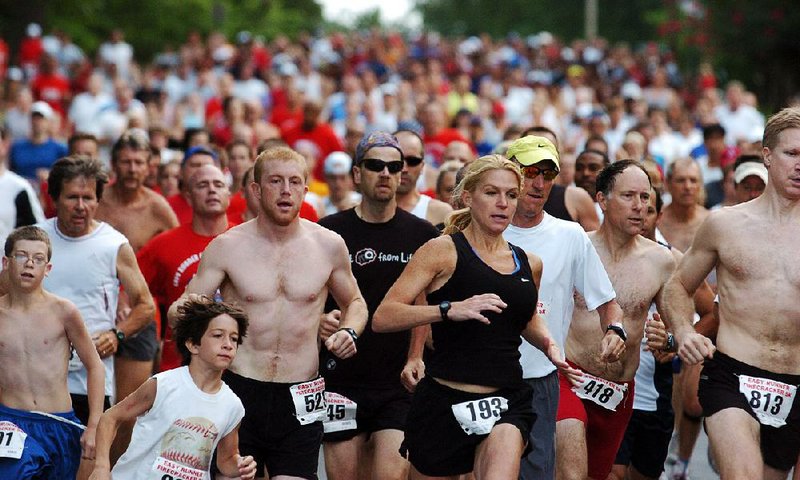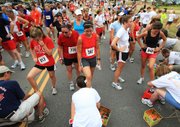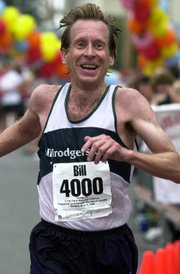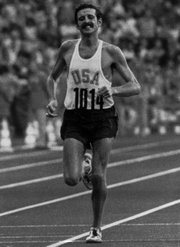The first Firecracker road race in Little Rock took place 39 years ago, during the early days of the nation's running boom.
There were 67 entrants, nearly all of them men.
Road race realities
Nationally, the half marathon continues to have the greatest composition of female participants, with 61 percent, followed by the 5K, with 59 percent of finishers being female and 10K races, with 58 percent. The marathon continues to skew male at 56 percent.
FEMALE MALE
5K 59% 41%
Median Time 36:15 29:43
Average Age 33.8 33.9
10K 58% 42%
Median Time 67:15 57:40
Average Age 36.6 38.8
HALF MARATHON 61% 39%
Median Time 2:22:21 2:04:00
Average Age 36.7 39.3
MARATHON 44% 56%
Median Time 4:45:30 4:20:13
Average Age 36.7 40.4
SOURCE Running USA (2015 statistics)
At a glance
40TH FIRECRACKER FAST 5K
LITTLE ROCK
STARTING TIME 7:30 a.m. Monday. Onsite registration opens at 6 a.m. at the Bank of America parking lot at the intersection of North University Avenue and Kavanaugh Boulevard, and closes at 7:15 a.m.
ROUTE Starting line at corner of North University and Kavanagh, continues down Kavanagh to Van Buren Street to Markham, continues on Fair Park Boulevard around War Memorial Stadium on Jonesboro Drive to North Monroe Street. Finish line at entrance to War Memorial Stadium parking lot.
2015 WINNERS Lauren Paquette (16:07.09); Jessee Duvall (16:03.67).
INTERNET firecrackerfast5k.racesonline. com
NOTES The course records are held by Ruben Reina (13:26) and Collette Murphy (15:23). … Olympic marathon champions Bill Rodgers, Frank Shorter, and Joan Benoit Samuelson have each run the Firecracker several times.
Demographics for the 40th Firecracker race, which starts at 7:30 a.m. Monday, have tilted in another direction as a second running boom continues to take hold.
This boom is all about the emerging wave of women runners.
Among the 1,253 Firecracker finishers last year, 632 were women and 621 men.
"There are more runners than ever right now, and that's mostly because of women," said Bill Rodgers, one of the men who triggered the first running boom with multiple victories in Boston and New York. "Women have changed the sport big-time, and I think more than anything, it's because here the doors have opened. It's not like a lot of popular sports, like football or baseball, where women don't have as many opportunities. In running the door is open."
Other Arkansas races reflect the influx of women.
For instance, 762 people finished the first Little Marathon, raced in 2003. Of those, 501 were men and 261 women. Last year, 1,213 women finished. There were 1,098 men finishers. In 1999, women made up 34.4 percent of 355 finishers at the Spa 10K in Hot Springs. At last year's Spa 10K, there were 429 finishers, of whom women were 57.1 percent.
Many believe the birth of this new boom appears to have come with a new federal law in 1972, coincidentally the same year of Frank Shorter's emergence as an American running star. Shorter and current Firecracker race director Sean Coughlan mentioned the influence of Title IX, which was introduced as a law that prohibited discrimination on the basis of sex in any federally funded education program or activity.
No one knows when, if ever, it will reach full fruition, but data in the sport of road running demonstrates no end in sight.
According to research conducted for USA Running, a nonprofit group organized on behalf of the American running industry, about 4.8 million people ran in U.S. road races in 1990. Of those, about 25 percent were women. Last year about 17.1 million raced. Women made up approximately 57 percent of that total.
"It has been no surprise to me to see women embracing the sport," Shorter said. He recalled his days as a student at Yale, when he used running as a form of stress release at the end of long days of study. Shorter said those sorts of benefits apply to everyone, regardless of gender. "For many women, it serves the same purpose," he said. "And then there's the socialization aspect of running. There are just so many people you can go run with, so to me, the large increase in women running was no surprise, and I think it's great. If you want gender equality, look to runners."
"I think we've had two booms," said Gary Smith, a former running store owner who established the first Firecracker race on July 4, 1977. "And the second one might have been bigger than the first."
Boom No. 1 was built on a foundation set by American track stars of the 1960s, including Billy Mills, Jim Ryun, and Marty Liquori.
Shoe stores, like the one owned by Little Rock's Smith, started popping up nationwide, and helped put the finishing touches on the boom with road races like the Firecracker.
The first Firecracker race, mapped out by Smith along 7 miles of neighborhood streets through Cammack Village and Little Rock's Heights, was held on July 4, 1977.
Shorter has raced on the current course, which came into existence in 1989, three times.
Shorter credits Smith, with his running store and Firecracker race, as among those instrumental in the sport's expansion beyond the base framed by gold medalist and champions.
"Races like the Firecracker 5K are personality driven," he said. "They are driven by certain kinds of personality. You have to have that, people who love to run and have great organizational skills. In his own low-key way, you had that in Gary. He gets things done."
Longtime runner Lou Peyton was one of a handful of women who ran the first Firecracker race, and she said the change in Arkansas is obvious.
When she first began to run, in 1968, she said she knew practically every woman runner in Little Rock by name.
"There's no doubt women have caught up and passed men in numbers," she said. "I notice it while I'm just out running on the River Trail."
Peyton, Rodgers, and Shorter each spoke of another change in the makeup of runners. "Back when I first started, almost everyone out there was male, and everyone was very thin, very fit," Peyton said. "Now you see men and women who are definitely heavy, but they are out there. I think everyone has figured out that you don't have to be thin to be healthy."
"You see some people who are very, very heavy out there running," Rodgers said. "You didn't see that 20 or 30 or 40 years ago, and we need that. We need everyone to know they have a place in our sport, and I think people are starting to figure that out. We still want the fast guys to show up, but also the joggers and walkers who aren't out there to set records. They're out there to get fit, and that's what it should be all about."
Shorter said America's running champions from the 1970s may have helped demystify the very act of running.
"We might have helped people to see that with running there was really nothing to be intimidated by," he said. "Initially I think it attracted very goal oriented runners, and mostly male. And then, shortly thereafter, when races began to open the door to women and encourage them to get involved, you saw more women out there, but most of them were also very competitive. But then as we moved into the 1980s, it began to expand out, and a lot of people came to the sport who knew they were never going to be very fast. They realized they just liked doing it."
Sports on 07/03/2016



